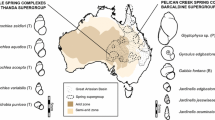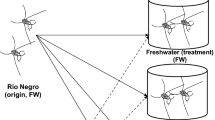Abstract
Salinity varies considerably among temporary pools in the Dead Sea Basin, Israel. We experimentally assessed the effects of four salinity levels (0, 10, 20 and 30 g NaCl per liter) on the aquatic insect community in this basin in an artificial pool experiment. Each salinity level was randomly assigned to six pools (total=24 pools). Salinity did not affect total insect abundance but strongly affected abundance and distributions of different species, and consequently, community structure. Of 13 taxa colonizing the pools, 12 were Diptera including 10 mosquito species. Five taxa were sufficiently common to assess abundance in relation to salinity. Polypedilum nubiferum Skuse (Diptera: Chironomidae) was largely salinity intolerant being abundant only in the freshwater. Ephydra flavipes Macquart (Diptera: Ephydridae) was most abundant at the highest salinity level and was rare in freshwater. Ochlerotatus caspius Pallas (Diptera: Culicidae) abundance tended to be highest at 10 g/l and lowest at 30 g/l although the differences were not statistically significant. Anopheles multicolor Cambouliu (Diptera: Culicidae) was relatively euryhaline although numbers dropped significantly at the highest salinity. Cleon dipterum Linnaeus (Baetidae: Ephemeroptera) was also euryhaline and showed no significant differences in abundance across salinities. For the mosquito species, we also estimated survival to pupation. Survival to pupation was significantly lower for O. caspius in freshwater, but was not statistically significantly different across salinities for A.␣multicolor. Species diversity was highest at the two lowest salinities tested and then dropped with increasing salinity. Evenness was not significantly different across salinities. Community similarity generally decreased with increasing salinity differences though dissimilarity was greatest when comparing freshwater to other salinities. Thus, regional diversity is likely increased when there is a range of salinities among pools.
Similar content being viewed by others
References
M. Begon J. L Harper C. R Townsend (1990) Ecology: Individuals, Populations and Communities EditionNumber2 Blackwell Scientific Publications Boston, Oxford, London, Edinburgh, Melbourne
L. Blaustein J. E Garb D Shebitz E Nevo (1999) ArticleTitleMicroclimate, developmental plasticity and community structure in artificial temporary pools Hydrobiologia 392 187–196 Occurrence Handle10.1023/A:1003559332439
A. J. Bohonak H. H Whiteman (1999) ArticleTitleDispersal of the fairy shrimp Branchinecta coloradensis (Anostraca): effects of hydroperiod and salamanders Limnology and Oceanography 44 487–493
J. E. Browerand J. H Zar C. Von Ende (1997) Field and Laboratory Methods for General Ecology McGraw-Hill New York
A. N. Clements (1992) The Biology of Mosquitoes EditionNumber1 Chapman and Hall London
M. R. Cunha M. H Moreira (1995) ArticleTitleMacrobenthos of Potamogeton and Myriophyllum beds in the upper reaches of Canal de Mira (Ria de Aveiro, NW Portugal): community structure and environmental factors Netherlands Journal of Aquatic Ecology 29 377–390 Occurrence Handle10.1007/BF02084237
Ch. Dimentman J Margalit (1981) ArticleTitleRain pools as breeding and dispersal sites of mosquitoes and other aquatic insects in the central Negev desert Journal of Arid Environments 4 123–129
A. Eitam L Blaustein M Mangel (2002) ArticleTitleEffects of Anisops sardea (Hemiptera: Notonectidae) on oviposition habitat selection by mosquitoes and other dipterans and on community structure in artificial pools Hydrobiologia 485 183–189 Occurrence Handle10.1023/A:1021315309758
F. Fagan W. L. E Hurd (1994) ArticleTitleHatch density variation of a generalist arthropod predator: population consequences and community impact Ecology 75 2022–2032
I. Gómez-Mestre M Tejedo (2002) ArticleTitleGeographic variation in asymmetric competition: a case study with two larval anuran species Ecology 83 2102–2111
N. J. Gotelli G. R Graves (1996) Null Models in Ecology Smithsonian Institute Press Washington and London
W. B. Grueber T. J Bradley (1994) ArticleTitleThe evolution of increased salinity tolerance in larvae of Aedes mosquitoes: a phylogenetic analysis Physiological Zoology 67 566–579
J. Heino (2000) ArticleTitleLentic macroinvertebrate assemblage structure along gradients in spatial heterogeneity, habitat size and chemistry Hydrobiologia 418 229–242 Occurrence Handle10.1023/A:1003969217686
T. A. Holland D. G Jenkins (1998) ArticleTitleComparison of processes regulating zooplankton assemblages in new freshwater pools Hydrobiologia 387-388 207–214 Occurrence Handle10.1023/A:1017093810178
M. Kiflawi L Blaustein M Mangel (2003) ArticleTitleOviposition habitat selection by the mosquito Culiseta longiareolata in response to risk of predation and conspecific larval density Ecological Entomology 28 168–173 Occurrence Handle10.1046/j.1365-2311.2003.00505.x
M. J. Kokkinn W. D Williams (1988) ArticleTitleAdaptations to life in a hypersaline water body adaptations at the egg and early embryonic stage of Tanytarsus barbitarsis freeman (Diptera: Chironomidae) Aquatic Insects 10 205–214
C. J. Krebs (1999) Ecological Methodology EditionNumber2 Benjamin Cummings Menlo Park, California, USA
W. E. Kunin (1995) ArticleTitleTowards an asymmetric index of community similarity Oikos 73 442–446
J. Margalit Ch. Dimentman A. S. Tahori (1988) ArticleTitleGeographical, seasonal and ecological distribution patterns of mosquito larvae (Diptera:Culicidae) in southern Israel Archives of Hydrobiology 112 233–249
S. E. Maxwell H. D Delaney (1990) Designing Experiments and Analyzing Data: A Model Comparison Perspective Wadsworth Belmont, California, USA
B. A. Menge J. P Sutherland (1987) ArticleTitleCommunity regulation variation in disturbance, competition and predation in relation to environmental stress and recruitment American Naturalist 130 730–757 Occurrence Handle10.1086/284741
F. W. Mosha C. M Mutero (1982) ArticleTitleThe influence of salinity on larval development and population dynamics of Anopheles merus Dönitz (Diptera: Culicidae) Bulletin of Entomological Research 72 119–128
Y. Nir R Goldwasser Y Lasoeski J Margalit (1968) ArticleTitleIsolation of West Nile virus strains from mosquitoes in Israel American Journal of Epidemiology 87 496–501 Occurrence Handle5652339
M. L. Patrick R. L. Ferreira R. J Gonzales C. M Wood R. W. Wilson T. J Bradley A. L Val (2002) ArticleTitleIon regulatory patterns of mosquito larvae collected from breeding sites in the Amazon rain forest Physiological and Biochemical Zoology 75 215–222 Occurrence Handle10.1086/342004 Occurrence Handle12177825
R. J. Pupedis (1997) ArticleTitleAquatic insects of the west-river and salt marshes of Connecticut Yale Forest and Environmental Studies Bulletin 100 162–177
A. Remane C Schlieper (1971) Biology of Fresh Water EditionNumber2 John Wiley and sons, Inc. New York, Toronto, Sydney
C. A. Rodriguez H Browman J. A Runge J. F. St-Pierre (2000) ArticleTitleImpact of solar ultraviolet radiation on hatching of a marine copepod, Calanus finmarchicus Marine Ecology Progress Series 193 85–93
T. J. Ryan C. T Winne (2001) ArticleTitleEffects of hydroperiod on metamorphosis in Rana sphenocephala American Midland Naturalist 145 46–53
Z. Saliternik (1966) ArticleTitleMethods of malaria eradication under the conditions peculiar to Israel Israel Journal of Medical Science 2 232–238
M. Spencer (1997) ArticleTitleThe effects of habitat size and energy on food web structure: an individual-based cellular automata model Ecological Modeling 94 299–316 Occurrence Handle10.1016/S0304-3800(96)00026-9
M. Spencer L Blaustein S. S Schwartz J. E Cohen (1999) ArticleTitleSpecies richness and the proportion of predatory animal species in temporal pools: relationships with habitat size and permanence Ecology Letters 2 157–166 Occurrence Handle10.1046/j.1461-0248.1999.00062.x
M. Spencer P Warren (1996) ArticleTitleThe effects of energy input, immigration and habitat size on food web structure: a microcosm experiment Oecologia Berlin 108 764–770 Occurrence Handle10.1007/BF00329053
T. W. Therriault J Kolasa (2000) ArticleTitleExplicit links among physical stress, habitat heterogeneity and biodiversity Oikos 89 387–391 Occurrence Handle10.1034/j.1600-0706.2000.890220.x
T. W. Therriault J Kolasa (2001) ArticleTitleDesiccation frequency reduces species diversity and predictability of community structure in coastal rock pools Israel Journal of Zoology 47 477–489
D. Tierney R. E Donnelly J. M Caffrey (1999) ArticleTitleGrowth of bream, Abramis brama (L.), in Irish canals and implications for management Fisheries Management and Ecology 6 487–498 Occurrence Handle10.1046/j.1365-2400.1999.00164.x
W.C.E.P Verberk A.M.T Brock G.A. Van-Duinen M. Van-Es J. T Kuper T. M. J Peeters M. J. A Smits L. Timan H Esselink (2002) ArticleTitleSeasonal and spatial patterns in macroinvertebrate assemblage in a heterogeneous landscape Proceedings of Experimental and Applied Entomology 13 35–43
Von Ende, C. N., 1993. Repeated-measures analysis: growth and other time-dependent measures. In Scheiner, S. M. & J. Gurevitch (eds), Design and Analysis of Ecological Experiments. Chapman and Hall, New York, New York, USA.
D. Ward L Blaustein (1994) ArticleTitleThe overriding influence of flash floods on species: area curves in ephemeral Negev desert pools: a consideration of the value of island biogeography theory Journal of Biogeography 21 595–603
M. W. Wilbur (1997) ArticleTitleExperimental ecology of food webs: complex systems in temporary ponds Ecology 78 2279–2302
H. Wolda (1981) ArticleTitleSimilarity indices, sample size and diversity Oecologia 50 296–302 Occurrence Handle10.1007/BF00344966
W. B. Worthen S Mayrose R. G Wilson (1994) ArticleTitleComplex interactions between biotic and abiotic factors: effects on mycophagous fly communities Oikos 69 277–286
W. A. Wurtsbaugh (1992) ArticleTitleFood-web modification by an invertebrate predator in the Great Salt Lake (USA) Oecologia 89 168–175
Author information
Authors and Affiliations
Corresponding author
Rights and permissions
About this article
Cite this article
Silberbush, A., Blaustein, L. & Margalith, Y. Influence of Salinity Concentration on Aquatic Insect Community Structure: A Mesocosm Experiment in the Dead Sea Basin Region. Hydrobiologia 548, 1–10 (2005). https://doi.org/10.1007/s10750-004-8336-8
Received:
Revised:
Accepted:
Issue Date:
DOI: https://doi.org/10.1007/s10750-004-8336-8




